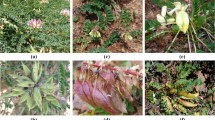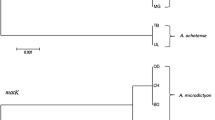Abstract
On the basis of morphology, chemical profiling, crossing ability, amplified fragment length polymorphism and comparison of nucleotide sequences of nuclear ribosomal internal transcribed spacer (ITS), the cultivated form of Withania somnifera, a species of therapeutic value, has been circumscribed as a new species, Withania ashwagandha. The present study was undertaken to ascertain whether the two species can be distinguished on the basis of DNA barcoding. Six barcode loci, ITS, ITS2, matK (maturase K), rbcL (ribulose-bisphosphate carboxylase/oxygenase, large subunit), rpoC1 (RNA polymerase-β′ subunit, main catalytic subunit) and trnH-psbA spacer (transfer RNA for histidine-photosystem II protein D1 spacer) from W. somnifera, W. ashwagandha, their hybrid, and ‘ashwagandha’ market samples were amplified, sequenced, and compared. ITS, ITS2 and matK distinguished two species on the basis of phylogenetic tree method. Likewise, BLAST 1 analysis based on ITS, ITS2, matK, and rbcL individually discriminated two species. However, on the basis of Kimura 2 Parameter distances, two species could not be distinguished as the requirement of a distinct barcode gap—the highest intraspecific distance being lower than the lowest interspecific distance—was not met by any of the loci. If compared by character-based method, ITS, ITS2 and matK sequences of the two species had distinct diagnostic nucleotides (pure character attributes) at nine, four and one positions, respectively. Interestingly, all market samples co-segregated and shared character attributes with W. ashwagandha.






Similar content being viewed by others
References
The Plant List (2013) Version 1.1. Published on the Internet. http://www.theplantlist.org/. Accessed 27 Apr 2015
Bhat WW, Lattoo SK, Razdan S, Dhar N, Rana S, Dhar R, Khan S, Vishwakarma RA (2012) Molecular cloning, bacterial expression and promoter analysis of squalene synthase from Withania somnifera (L.) Dunal. Gene 499:25–36
Kuttan G (1996) Use of Withania somnifera as an adjuvant during radiation therapy. Indian J Exp Biol 34:854–856
Ziauddin M, Phnasalkar N, Patki P, Diwanay S, Patwardhan B (1996) Studies on the immunomodulatory effects of Ashwagandha. J Ethnopharmacol 50:69–76
Andallu B, Radhika B (2000) Hypoglycemic, diuretic and hypocholesterolemic effect of winter cherry (Withania somnifera, Dunal) root. Indian J Exp Biol 38:607–609
Davis L, Kuttan G (2000) Effect of Withania somnifera on cyclophosphamide-induced urotoxicity. Cancer Lett 148:9–17
Mirjalili MH, Moyano E, Bonfill M, Cusido RM, Palazon J (2009) Steroidal lactones from Withania somnifera, an ancient plant for novel medicine. Molecules 14:2373–2393
Sehgal N, Gupta A, Valli RK, Joshi SD, Mills JT, Hamel E, Khanna P, Jain SC, Thakur S, Ravindranath V (2012) Withania somnifera reverses Alzheimer’s disease pathology by enhancing low-density lipoprotein receptor-related protein in liver. Proc Natl Acad Sci USA 109:3510–3515
Mir BA, Khazir J, Hekeem KR, Kumar A, Koul S (2014) Withanolides array of Withania ashwagandha sp. novo populations from India. Ind Crop Prod 59:9–13
Mir BA, Koul S, Kumar A (2010) Intraspecific variation in the internal transcribed spacer (ITS) regions of rDNA in Withania somnifera (Linn.) Dunal. Indian J Biotechnol 9:325–328
Kumar A, Mir BA, Sehgal D, Dar TH, Koul S, Kaul MK, Raina SN, Quazi GN (2011) Utility of a multidisciplinary approach for genome diagnostics of cultivated and wild germplasm resources of medicinal Withania somnifera, and the status of new species, W. ashwagandha, in the cultivated taxon. Plant Syst Evol 291:141–151
Kaul KN (1957) The origin, distribution and cultivation of ‘Ashwagandha’ the so called Withania somnifera of Indian literature. In: Proceedings of symposium utilization of Indian medicinal plants. National Botanic Gardens, CSIR, Lucknow, pp 7–8
Sastry MS, Dhalla NS, Malhotra CL (1960) Chemical examination of Withania ashwagandha Kaul. Indian J Pharmacol 22:205–208
Dhalla NS, Gupta KC, Sastry NS, Malhotra CL (1961) Comparative studies on Withania somnifera Dunal and Withania ashwagandha Kaul. Indian J Pharmaco 23:126–127
Negi MS, Singh A, Lakshmikumaran M (2000) Genetic variation and relationship among and within Withania species as revealed by AFLP markers. Genome 43:975–980
Negi MS, Sabharwal V, Wilson N, Lakshmikumaran MS (2006) Comparative analysis of the efficiency of SAMPL and AFLP in assessing genetic relationships among Withania somnifera genotypes. Curr Sci 91:464–471
Hebert PDN, Cywinska A, Ball SL, deWaard JR (2003) Biological identifications through DNA barcodes. Proc R Soc B 270:313–321
Kress WJ, Wurdack KJ, Zimmer EA, Weight LA, Janzen DH (2005) Use of DNA barcodes to identify flowering plants. Proc Natl Acad Sci USA 102:8369–8374
Ratnasingham S, Hebert PDN (2007) BOLD: the barcode of life data system (http://barcodinglife.org). Mol Ecol Notes 7:355–364
Parveen I, Singh HK, Raghuvanshi S, Pradhan UC, Babbar SB (2012) DNA barcoding of endangered Indian Paphiopedilum species. Mol Ecol Resour 12:82–90
Singh HK, Parveen I, Raghuvanshi S, Babbar SB (2012) The loci recommended as universal barcodes for plants on the basis of floristic studies may not work with congeneric species as exemplified by DNA barcoding of Dendrobium species. BMC Res Notes 5:42
CBOL Plant Working Group (2009) A DNA barcode for land plants. Proc Natl Acad Sci USA 106:12794–12797
Chen S, Yao H, Han J, Liu C, Song J, Shi L, Zhu Y, Ma X, Gao T, Pang X, Luo K, Li Y, Li X, Jia X, Lin Y, Leon C (2010) Validation of ITS2 region as a novel DNA barcode for identifying medicinal plant species. PLoS ONE 5:e8613
China Plant BOL Group, Li DZ, Gao LM, Li HT, Wang H, Ge XJ, Liu JQ, Chen ZD, Zhou SL, Chen SL, Yang JB, Fu CX, Zeng CX, Yan HF, Zhu YJ, Sun YS, Chen SY, Zhao L, Wang K, Yang T, Duan GW (2011) Comparative analysis of a large dataset indicates that internal transcribed spacer (ITS) should be incorporated into the core barcode for seed plants. Proc Natl Acad Sci USA 108:19641–19646
Hollingsworth PM (2011) Refining the DNA barcodes for land plants. Proc Natl Acad Sci USA 108:19451–19452
Kress WJ, Erickson DL (2007) A two-locus global DNA barcode for land plants: the coding rbcL gene complements the non-coding trnH-psbA spacer region. PLoS ONE 2:e508
Doyle JJ, Doyle JL (1987) A rapid DNA isolation procedure for small quantities of fresh leaf tissue. Phytochem Bullet 19:11–15
Hu YJ, Saedler H (2007) Evolution of the inflated calyx syndrome in solanaceae. Mol Biol Evol 24:2443–2453
Fay MF, Swensen SM, Chase MW (1997) Taxonomic affinities of Medusagyne oppositifolia (Medusagynaceae). Kew Bullet 52:111–120
Olmstead RG, Michaels HJ, Scott KM, Palmer JD (1992) Monophyly of the Asteridae and identification of their major lineages inferred from DNA sequences of rbcL. Ann Missouri Bot Gard 79:249–265
White TJ, Bruns T, Lee S, Taylor JW (1990) Amplification and direct sequencing of fungal ribosomal RNA genes for phylogenetics. In: Innis MA, Gelfand DH, Sninsky JJ, White TJ (eds) PCR protocols: a guide to methods and applications. Academic Press, New York, pp 315–322
Tate JA, Simpson BB (2003) Paraphyly of Tarasa (Malvaceae) and diverse origins of the polyploid species. Syst Bot 28:723–737
Sang T, Crawford DJ, Stuessy TF (1997) Chloroplast DNA phylogeny, reticulate evolution and biogeography of Paeonia (Paeoniaceae). Am J Bot 84:1120–1136
Hall TA (1999) BioEdit: a user-friendly biological sequence alignment editor and analysis program for Windows 95/98/NT. Nucleic Acids Symp Ser 41:95–98
Tamura K, Stecher G, Peterson D, Filipski A, Kumar S (2013) MEGA6: molecular evolutionary genetics analysis version 6.0. Mol Biol Evol 30:2725–2729
Rach J, DeSalle R, Sarkar IN, Schierwater B, Hadrys H (2008) Character-based DNA barcoding allows discrimination of genera, species and populations in Odonata. Proc R Soc Lond B Biol Sci 275:237–247
Bergmann T, Hadrys H, Breves G, Schierwater B (2009) Character-based DNA barcoding: a superior tool for species classification. Berliner und Münchener Tierarztliche Wochenschrift 122:446–450
DeSalle R, Egan MG, Siddall M (2005) The unholy trinity: taxonomy, species delimitation and DNA barcoding. Philos Trans R Soc B 360:1905–1916
Atal CK, Schwarting AE (1962) Intraspecific variability in Withania somnifera. I. A preliminary survey. Llyodia 25:78–87
Velzenvan R, Weitschek E, Felici G, Bakker FT (2012) DNA barcoding of recently diverged species: relative performance of matching methods. PLoS ONE 7:e30490
Meyer CP, Paulay G (2005) DNA barcoding: error rates based on comprehensive sampling. PLoS Biol 3:2229–2238
Lahaye R, Van Der Bank M, Bogarin D, Warner J, Pupulin F, Gigot G, Maurin O, Duthoit S, Barraclough TG, Savolainen V (2008) DNA barcoding the floras of biodiversity hotspots. Proc Natl Acad Sci USA 105:2923–2928
Dexter KG, Pennington TD, Cunningham CW (2010) Using DNA to assess errors in tropical tree identifications: how often are ecologists wrong and when does it matter? Ecol Monogr 80:267–286
Alvarez I, Wendel JF (2003) Ribosomal ITS sequences and plant phylogenetic inference. Mol Phylogenet Evol 29:417–434
Bailey CD, Carr TG, Harris SA, Hughes CE (2003) Characterization of angiosperm nrDNA polymorphism, paralogy, and pseudogenes. Mol Phylogenet Evol 29:435–455
Hollingsworth PM, Graham SW, Little DP (2011) Choosing and using a plant DNA barcode. PLoS ONE 6:e19254
Federici S, Galimberti A, Bartolucci F, Bruni I, De Mattia F, Cortis P, Labra M (2013) DNA barcoding to analyse taxonomically complex groups in plants: the case of Thymus (Lamiaceae). Bot J Linn Soc 171:687–699
Matsuoka Y (2011) Evolution of polyploid Triticum wheats under cultivation: the role of domestication, natural hybridization and allopolyploid speciation in their diversification. Plant Cell Physiol 52:750–764
Dempewolf H, Hodgins KA, Rummell SE, Ellstrand NC, Rieseberg LH (2012) Reproductive isolation during domestication. Plant Cell 24:2710–2717
Purugganan MD, Fuller DQ (2009) The nature of selection during plant domestication. Nature 457:843–848
Acknowledgements
The authors thank Dr. Sushma Koul formerly from the Biodiversity and Applied Botany Division, Institute of Integrative Medicine, Jammu for providing the plant material. They gratefully acknowledge the financial support provided by the Indian Council of Medical Research, New Delhi to S.B.B. in form of a research project. S.M. too thankfully acknowledges the receipt of Junior and Senior Research fellowships from this project. The present work was also partially supported by a Research and Development grant provided to S.B.B. by the University of Delhi. The language editing of the manuscript by Dr. Anupam Raina, a professional copy editor, is gratefully acknowledged.
Author information
Authors and Affiliations
Corresponding author
Ethics declarations
Conflict of interest
The authors declare that they have no conflict of interest.
Additional information
Significance statement
Withania somnifera, ‘Ashwagandha’, is an important medicinal plant. Because of its high demand, it has been domesticated and is cultivated. There have many suggestions that its cultivated form has diverged enough from the parent species to be treated as a new species, W. ashwagandha. The present work, based on DNA barcoding, confirms its species-level status and provides an effective identification tool for checking substitutions in its market samples.
Electronic supplementary material
Below is the link to the electronic supplementary material.
Rights and permissions
About this article
Cite this article
Malik, S., Mir, B.A., Singh, H.K. et al. DNA Barcodes Distinguish Withania somnifera and Withania ashwagandha . Proc. Natl. Acad. Sci., India, Sect. B Biol. Sci. 88, 1413–1424 (2018). https://doi.org/10.1007/s40011-017-0879-3
Received:
Revised:
Accepted:
Published:
Issue Date:
DOI: https://doi.org/10.1007/s40011-017-0879-3




